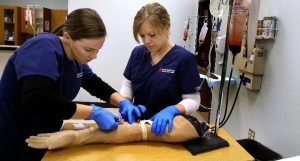How to become a Medical Assistant

You’ve always been someone who lends a hand to others. Everyone knows you’ve been destined for a career in medicine since childhood, whether you’ve always been the friend with tissues and ibuprofen on hand or the one binge-watching medical dramas in your spare time. A career as a medical assistant is a fantastic choice if you want to get into the healthcare profession quickly. Working as a medical assistant entails performing regular diagnostic procedures, documenting vital signs, and administering drugs and first assistance to patients. If this sounds like something you’d be interested in, keep reading to learn more about what it takes to become a medical assistant and how to get started.
How to Become a Medical Assistant
There are a few crucial steps to become a medical assistant. Learn more about the important milestones to keep in mind along the process.
Get a certificate in medical Assistance.
While some medical assistants may be able to obtain work right out of high school, according to the Bureau of Labor Statistics, many employers prefer candidates who have completed postsecondary training programs.
Furthermore, many businesses prefer to hire certified medical assistants (CMAs) or registered medical assistants (RMAs), both of which require candidates to finish a certificate or diploma program.
Consider elements including alumni results, program accreditation, how courses are offered (online versus in-person), commute time, program expenses, and the hands-on training you’ll receive when choosing a medical assisting program.
Some of these considerations may have a significant impact on your selection. While online classes may be more convenient, you’ll want to make sure you acquire a mix of crucial hands-on experience because direct patient care employment necessitates practice. The Medical Assisting program at Rasmussen College comprises both residential and online courses. Students gain valuable hands-on experience in the on-campus courses by learning various patient care practices such as patient triage strategies and how to assist with various procedures. This practical training prepares potential medical assistants to present themselves professionally and confidently on the first day of their new jobs.
Read more:Oxford University acceptance rate
Internships might help you gain experience as a medical assistant.
In addition to coursework and laboratories, you’ll want to complete an internship or externship near the end of your medical assisting program. During this time, you’ll have the chance to put what you’ve learned in class into practice at a clinic, specialized practice, or hospital. Students work alongside experienced medical assistants and are frequently given tasks such as collecting blood from patients under supervision.
Not only will this experience provide you with numerous highlights for your CV, but you will also feel confident heading into job interviews following graduation.
Pufall is proud of the professionalism that the curriculum instills in pupils. When their students and graduates enter their facilities, their employers frequently comment on how professional they are.
Obtain certification.
As previously said, you may be required to pass a certification exam based on your employer’s preferences and the state in where you wish to work. The Certified Medical Assistant CMA (AAMA) test and the Registered Medical Assistant (RMA) exam are the two main certification alternatives. Anatomy and physiology, medical terminology, safety, and legal compliance will all be covered in both classes. Does it appear to be threatening? Don’t worry too much about it; a good medical assistant program will teach you everything you need to know.
If certification isn’t required by businesses in your area, remember that pursuing one of these options is still a great opportunity to improve your resume and stand out as a candidate when applying.
Take note of your abilities.
After completing a medical assisting program, you’ll have access to a whole new set of skills. In terms of technical abilities, you should be well-versed in:
- Terminology used in medicine
- Etiquette for patients
- How to Make the Most of Electronic Health Records (EHR)
- How to carry out administrative responsibilities in the healthcare field
These are hard abilities that you should emphasize on your CV, but don’t overlook soft skills. These skills, also known as transferable skills, are ones you may have had before but have refined during your time in school. You’ll use soft skills as a medical assistant, such as:
- Empathy—health concerns can be frightening, and a little empathy can make your patient feel a lot better.
- Multitasking—medical assistants are required to perform a variety of tasks in a short amount of time. Keeping your mind and body active can make it easier to cross stuff off your to-do list.
- Medical assistants operate as part of a team of healthcare practitioners in an atmosphere where effective communication is essential for patient safety and facility efficiency.
- When applying for and interviewing for medical assistant positions, examples and stories of how you’ve used your soft skills to help others will come in handy. Remember to write down any instances you come up with during your medical assisting training so you can refer to them later.
Submit an application and attend an interview
This is where it all comes together! It is in your best interests to seek out, take initiative, and pursue the type of employment you desire, regardless of your level of education. If you’re willing to relocate, the processes you need to follow to obtain an MA, including certification, may be affected. Continue going over your résumé, practicing interview responses, and honing your technical skills. Consider volunteering at a local hospital to add more healthcare experience to your resume if your job search is taking longer than you’d like.
It’s also a good idea to apply to a range of locations, such as clinics, specialty centers, and hospitals. Be open to the options, even if you have your heart set on a specific job. When you arrive for your interview, you may discover that you enjoy the atmosphere more than you anticipated.
Keep in mind that if you have a degree or credential, your school may be able to connect you with alumni in the area who may know of opportunities or can set you up with the proper person for an interview. Also, if you had a good time at your medical assisting externship, inquire whether the staff is aware of any chances at their company or in their network. You never know where a link will take you!
Related Post:What is MCA (Master of Computer Applications)?
What to do when you’ve completed your training as a medical assistant
Getting your first job as a medical assistant is a huge step forward in your healthcare career, but it doesn’t mean you’re done yet. Take advantage of on-the-job training and make yourself at home.
When you acquire your first medical assistant position, you’ll be eager to get started. But don’t be surprised if you don’t fly solo the first week. Many clinics and hospitals will wish to train you on their particular procedures and organizational structures.
It’s possible that your on-the-job training will be considerably more comprehensive if you haven’t completed a medical assisting school. Medical vocabulary, instrument names, how to interact professionally with patients, and how to conduct duties like taking blood, performing common operations, and utilizing electronic health records (EHR) software will all be taught to you by physicians or other medical assistants. Depending on the workplace and speciality, all of this training can take several months, but it is critical to your success as a medical assistant.
Think about your long-term career goals.
For some, medical assisting is the ideal long-term job, while others may be seeking ways to broaden their scope of work or branch out into other areas of healthcare. Working as a medical assistant gives you significant experience and insight into the inner workings of a healthcare facility, which is good news if you’re seeking for more topics to pursue down the road. This can make learning the ropes in a new role go more smoothly. Medical assistants may choose to consider the following frequent healthcare careers:
FAQs
What are the responsibilities of medical assistants?
Medical assistants are responsible for a variety of clinical and administrative tasks. These can vary based on the employer and state legislation governing medical assistants, but they typically involve the following:
- Greeting patients as they enter the practice or department
- Making and receiving phone calls
- Referrals or prescriptions on behalf of a patient are called in.
- Getting exam rooms ready and aiding the doctor during the exam
- Patients’ height, weight, and blood pressure are all measured.
- Taking blood samples from patients and preparing them to be submitted to the lab
- Keeping track of patient information
- Assisting with bookkeeping or placing orders for supplies
- As directed by a physician or nurse, removing sutures, providing an injection, or treating wounds.
What types of medical assistants are there?
Clinical medical assistants and administrative medical assistants are two types of medical assistants. Clinical medical assistants will mostly assist with medical examinations, lab sample collection, and other tasks that aid in the diagnosis or care of a patient. Administrative medical assistants will be responsible for maintaining patient records, bookkeeping, making phone calls, and other related duties. The majority of medical assistants work in both the clinical and administrative fields.
Do Medical assistants operate in a variety of settings?
The US Bureau of Labor Statistics (BLS) states that 57 percent of medical assistants worked in doctors’ offices in 2019, the most recent year for which data is available. Hospitals employed 15% of the workforce, outpatient care clinics employed 8%, and chiropractic offices employed 4%.
What’s the difference between medical assistants and physician’s assistants?
Yes! Medical assistants help with administrative responsibilities as well as performing basic clinical duties. They usually have a certificate or certification from a post-secondary institution, but not a degree.
Under the supervision of a physician, physician assistants (PAs) can examine, treat, and diagnose patients. PAs may also prescribe medication and order testing such as x-rays, depending on the state in which they practice. Most states require PAs to have a master’s degree and a license to practice, according to the BLS.
What should you know before pursuing a career as a medical assistant?
You must be a high school graduate or have a GED to enroll for our medical assistant diploma program. We don’t require certain requirements, however having a basic understanding of math and science principles, as well as attention to detail, can help.
What is the average time it takes to become a medical assistant?
Training for a profession as a medical assistant usually takes less than a year. You can learn to be a medical assistant in as little as ten months at Altierus. If you decide to seek certification, you may need a few extra months after graduation to prepare for your exam.
Is a degree required to work as a medical assistant?
You don’t have it. As previously stated, a post-secondary diploma qualifies you to work as a medical assistant.
In some states, on-the-job training is available to become a medical assistant. Employers, on the other hand, are more inclined to choose individuals who have received official training and certification.
Is certification required for medical assistants?
To work as a medical assistant, you don’t need to be certified. Certification, on the other hand, can help you stand out when it comes time to apply for medical assistant jobs following graduation.
The following are two of the most popular medical assistant certification programs:
- The American Association of Medical Assistants (AAMA) offers the Certified Medical Assistant (CMA) certification.
- The American Medical Technologists (AMT) administers the Registered Medical Assistant (RMA) program.
Related Post:Easiest PA Schools to Get into
What does a medical assistant make?
In May 2019, the BLS reported that the national median annual wage for medical assistants was $34,800. Medical assistants in the bottom 10% earned less than $25,820, while those in the top 10% earned more than $48,720.
Is it worthwhile to pursue a career as a medical assistant?
If you enjoy assisting others and are interested in medicine, becoming a medical assistant can be a terrific way to start a rewarding career. Furthermore, during the next ten years, demand for medical assistants is expected to increase rapidly. Medical assistant job vacancies are expected to expand by 19 percent between 2019 and 2029, according to the BLS, which is substantially faster than the overall job growth rate of 4%.
Medical assistant training can provide you with in-demand skills that can benefit others. That, we believe, is well worth it!
Related Post:Tuition Free Medical Schools







